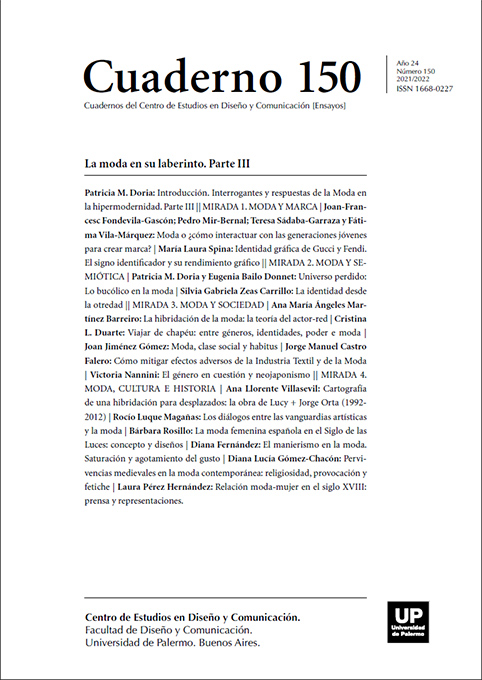El género en cuestión y neojaponismo
Abstract
In the current scenario it is possible to glimpse hybridizations of styles that ignore any rule about fashion, mixing aesthetics that previously seemed incompatible, acting in parallel and without adhering to a single fashion subculture. From netnography, consumptions of a genderless or non-binary fashion stand out, intimately intertwined with others influenced by Japanese popular culture or neo-Japaneseism, which manifest gender transgressions with greater comfort. Therefore, in this writing, these two salient themes that have become the continent of current subjectivities in their expressions of fashion consumption through digital media will be addressed.
References
Bard, C. (2012). Historia política del pantalón. Barcelona: Tusquets. (Trabajo original publicado en 2010).
Bonami, F. & Simons, R. (Eds.). (2003). The fourth sex: adolescent extremes. Milan: Charta.
Butler, J. (1998). Actos performativos y constitución del género: un ensayo sobre fenomenología y teoría feminista. Debate feminista, 18, 296-314. El género en disputa. Barcelona: Paidós.
Clark, L. (1995). Kids. Nueva York: Independent Pictures.
Coppola, S. (1999). Las Vírgenes Suicidas. Toronto: American Zoetrope.
Dana, M. (2020). Moda no binaria. Análisis sociocomunicativo de un cambio epocal. Tesina de grado de la Licenciatura en Comunicación Social. Universidad Nacional de Rosario, Rosario.
Edel, U. (1981). Christiane F. Berlin: Solaris Film.
Entwistle, J. (2002). El cuerpo y la moda. Una visión sociológica. Barcelona: Paidós.
Eugenides, J. (1993). Las Vírgenes Suicidas. Nueva York: Farrar, Strauss and Giroux.
Featherstone, M. (1991). Cultura de consumo y posmodernismo. Buenos Aires: Amorrortu.
Flugel, J. C. (1964). Psicología del vestido. Buenos Aires: Paidós
Frisa, M.L. (2020). Las formas de la moda. Cultura, industria, mercado. Buenos Aires: Ediciones Ampersand.
Freedman & Slade (Eds). (2018). Introducing Japanes Popular Culture. Londres, Nueva York: Routledge.
Guadagnino, L. (2020). We Are Who We Are. Venecia: HBO.
Haenfler, R. (2014). Subcultures. The basics. London: Routledge.
Hermann, K. & Rieck, H. (1978). Wir Kinder vom Bahnhof Zoo. Hamburgo: Gruner + Jahr.
Iwabuchi, K. (2002). Recentering globalization: Popular culture and Japanese transnationalism. London: Duke University Press.
Leo, J. R. (2018). La estética mukokuseki en el contexto del neo japonismo. Kokoro: Revista para la difusión de la cultura japonesa, (5).
Levinson, S. (2019). Euphoria. Pomona: HBO.
Linares Varga, A. (2019). Harajuku Parte I, Nihon Criollo, Abril, Recuperado de https://nihoncriollo.wixsite.com/nihoncriollo/post/harajuku-j-fashion-parte-1 [Último acceso 30 de septiembre de 2020].
McNay, L. (1992). Foucault and Feminism: Power, Gender and the Self. Cambridge: Polity Press.
Miyazaki, H. (1989). Kiki’s Delivery Service. Tokyo: Studio Ghibli.
Nannini, V. (2020). Fashion Consumption in Digital Media: Multiple Practices and New Identities. Fashion, Style and Popular Culture, 7 (4). August. Londres: Intellect Books.
Peirce, K. (1999). Boys Don’t Cry. Texas: Fox Searchlight Pictures.
Polhemus, T. (1994). Streetstyle: from sidewalk to catwalk. Londres: Thames & Hudson.
Rissotto, V. y Maciá, L. (2020) Conversación política en plataformas digitales. Question/ Cuestión, 2(66), e495-e495.
Silverman, K. (1986). Fragments of a fashionable discourse. Studies in entertainment: Critical approaches to mass culture. Indiana: Indiana University, pp. 139-154.
Slade, T. (2018) Cute Fashion: The Social Strategies and Aesthetics of Kawaii. Introducing Japanese Popular Culture (pos. 399-411). London: Routledge.
Steele, V. (1985). Fashion and eroticism. Nueva York: Oxford University Press.
Wilson, E. (1989). Adorned in dreams. Fashion and modernity. Londres: Rutgers University Press.
Yonebayashi, H. (2014). Omoide no Marnie. Tokyo: Studio Ghibli.
Zambrini, M.L. (2008) Cuerpos, indumentarias y expresiones de género: el caso de las travestis de la Ciudad de Buenos Aires. Todo sexo es político. Estudios sobre sexualidades en Argentina. Buenos Aires: Libros del Zorzal.
Los autores/as que publiquen en esta revista ceden los derechos de autor y de publicación a "Cuadernos del Centro de Estudios de Diseño y Comunicación", Aceptando el registro de su trabajo bajo una licencia de atribución de Creative Commons, que permite a terceros utilizar lo publicado siempre que de el crédito pertinente a los autores y a esta revista.


